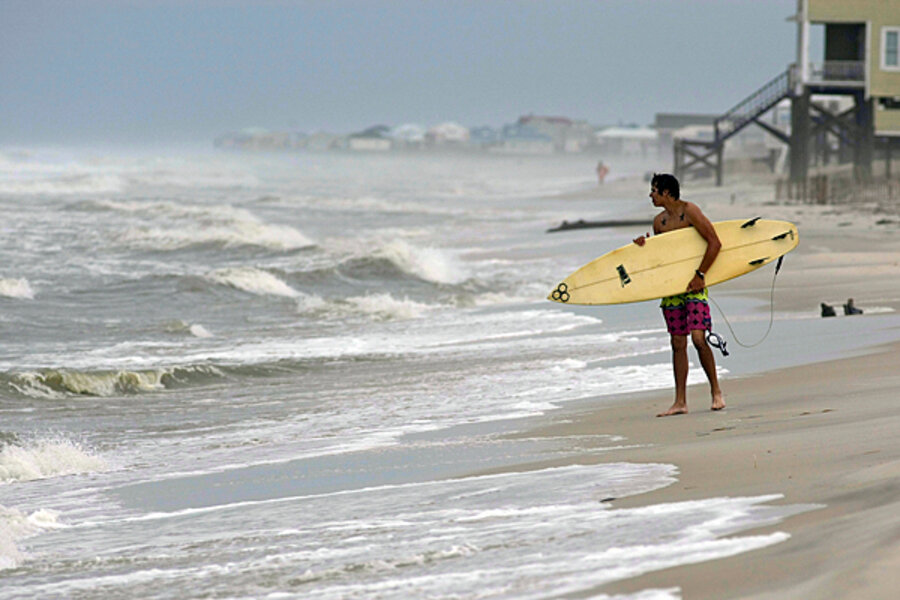Tropical Storm Lee could hit as near-hurricane with 20 inches of rain
Loading...
Tropical-storm warnings have been posted along the US Gulf Coast in anticipation of what could become tropical storm Lee before the end of Friday.
As of 11 a.m. Eastern time Friday, forecast offices had issued tropical-storm warnings that stretched from Sabine Pass, Texas to Pascagoula, Miss.
The center of the storm, currently known only as tropical depression 13, is located some 300 miles southwest of Houston and some 224 miles south-southeast of New Orleans.
The storm center is expected to close in on the southeastern coast of Louisiana this weekend at near-hurricane strength, according to the latest forecast from the National Hurricane Center in Miami.
It is currently is projected to dump 10 to 15 inches of rain on southern portions of Louisiana, Mississippi, and Alabama, with isolated pockets getting up to 20 inches.
Forecasters say they expect a storm surge of 2 to 4 feet along the coasts affected by the storm's on-shore winds.
The potential for large rainfall totals stems from the significant amounts of moisture feeding the storm and from its glacial pace, forecasters say. The storm system is moving at a lethargic 2 miles an hour. (By contrast, hurricane Katia, currently in the Atlantic, is traveling a bit more smartly along its path at some 15 miles an hour.)
Along the Gulf Coast, emergency managers are gearing up for tropical depression 13.
On Thursday, ExxonMobil and Royal Dutch Shell evacuated some of their offshore platforms in anticipation of the storm's arrival.
If the storm behaves as currently forecast, it will bring badly needed water to a drought-parched portion of the country.
Along with Texas, Arizona, and New Mexico, Louisiana, Mississippi, and Alabama also are enduring drought conditions that range from severe in eastern Alabama and Southern Mississippi to exceptional in western Louisiana.
Some local officials, however, are concerned about receiving too much of a good thing.
"Sometimes you get what you ask for," New Orleans Mayor Mitch Landrieu told the Associated Press. "Unfortunately it looks like we're going to get more than we needed."
Katia bears down
As the Gulf Coast prepares for its first land-falling tropical cyclone, Katia continues to head generally northwest toward the southeastern Atlantic Coast.
As of 11 a.m. Eastern time, Katia was located some 1,000 miles west of Antigua and Barbuda, in the Leeward Islands and 2,100 miles south southeast of Bermuda.
Maximum sustained winds are estimated at around 75 miles an hour, with tropical-storm-force winds extending up to 155 miles an hour from the center of the storm.
Forecasters briefly demoted Katia from hurricane to tropical storm Thursday evening after Katia encountered a low pressure system forecasters had been tracking for its potential influence on the tropical cyclone's intensity. The low-pressure system introduced wind shear strong enough to disrupt Katia's intensification.
By early Wednesday morning, Katia could reach "major" status, with maximum sustained winds of more than 110 miles an hour.
By then the track forecast puts Katia about 1,300 miles east of Miami and about 620 miles south southwest of Bermuda.
Forecasters caution, however, that the current track forecasts can be off by as much as 250 miles for Wednesday's position, and wind-speed forecasts can be off by as much as 23 miles an hour for each day beyond a storm's current intensity estimate.
With hurricane Katia – and likely tropical storm Lee – on the their platter, forecasters at the National Hurricane Center in Miami also are watching a stormy patch in the Atlantic about 450 miles south of Halifax, Nova Scotia. The system stands a 60 percent chance of reaching tropical-storm status within the next two days.
If it makes the cut, it would become tropical storm Nate. The good news for storm-weary East Coast residents: It's projected to continue traveling northeast into the North Atlantic.





